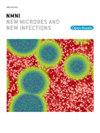Enhanced immunogenicity of COVID-19 RBD fused to mutant scorpion's phospholipase D for vaccine development
IF 5.4
Q2 INFECTIOUS DISEASES
引用次数: 0
Abstract
The management of the global COVID-19 pandemic relies, in part, on the rapid development of preventive vaccines at an unparalleled speed. The infection caused by the coronavirus is facilitated by the spike glycoprotein trimmer located on the surface of the virion, specifically through its receptor binding domain (RBD). The response of antibodies to this domain is a key indicator of the immunization's effectiveness and is well correlated with the neutralization of the viral agent. The failure of COVID-19 vaccines to induce complete neutralization provides an opportunity to find an alternative way. In this study, we show that recombinant RBD, Wuhan-specific; fused to mPLD1 protein, a highly effective immunogen from Hemiscorpius lepturus scorpion's venom, induce a potent immune response in mouse model. Conventional virus neutralization test (cVNT) with serum of mice immunized with mPLD1-RBD fusion protein, protects the Vero cells against the Omicron and Wuhan variants at the minimum of 1/64 and 1/32 dilution, respectively. The data strongly suggests that the subunit recombinant fusion protein could be a promising candidate for vaccine development against COVID-19. Our research showed that fusion of mPLD1, a highly effective immunogen, with RBD significantly boosts the immune response and substantially amplifies RBD antigenic properties in lab animals, setting the stage for their assessment in a comprehensive preclinical study.
COVID-19 RBD与突变蝎子磷脂酶D融合用于疫苗开发的增强免疫原性
COVID-19全球大流行的管理在一定程度上依赖于以无与伦比的速度快速开发预防性疫苗。冠状病毒引起的感染是由位于病毒粒子表面的刺突糖蛋白修饰物促进的,特别是通过其受体结合域(RBD)。抗体对该结构域的反应是免疫效果的关键指标,并与病毒因子的中和密切相关。COVID-19疫苗未能诱导完全中和,这为寻找替代方法提供了机会。在这项研究中,我们发现重组RBD,武汉特异性;与半角蝎毒液中高效免疫原mPLD1蛋白融合,在小鼠模型中诱导强效免疫应答。用mPLD1-RBD融合蛋白免疫小鼠血清进行常规病毒中和试验(cVNT),分别在至少1/64和1/32稀释时保护Vero细胞免受Omicron和武汉变体的感染。这些数据有力地表明,亚基重组融合蛋白可能是开发COVID-19疫苗的有希望的候选者。我们的研究表明,高效免疫原mPLD1与RBD的融合显著增强了实验动物的免疫反应,并显著增强了RBD的抗原特性,为其在全面的临床前研究中的评估奠定了基础。
本文章由计算机程序翻译,如有差异,请以英文原文为准。
求助全文
约1分钟内获得全文
求助全文
来源期刊

New Microbes and New Infections
Medicine-Infectious Diseases
CiteScore
10.00
自引率
2.50%
发文量
91
审稿时长
114 days
 求助内容:
求助内容: 应助结果提醒方式:
应助结果提醒方式:


